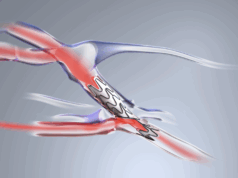 In a recent study, Victor Demaerel (University Hospitals Leuven, Leuven, Belgium) and colleagues found that tunnelled haemodialysis catheter (THC) survival in 352 patients was more than 70% after five years. This finding, they conclude, “supports [THC] use for permanent dialysis access”.
In a recent study, Victor Demaerel (University Hospitals Leuven, Leuven, Belgium) and colleagues found that tunnelled haemodialysis catheter (THC) survival in 352 patients was more than 70% after five years. This finding, they conclude, “supports [THC] use for permanent dialysis access”.
The literature is divided about the potential role of THC as a permanent access for haemodialysis and about which patients are at high risk of THC-related complications, the authors write in the Journal of Vascular Access (JVA). They elaborate: “The native arteriovenous (AV) fistula is widely recognised as the optimal vascular access,” noting its association with “excellent” long-term patency and a low complication rate. THCs, on the other hand, “are considered a less reliable permanent access for haemodialysis due to higher rates of infection and thrombosis”.
However, Demaerel et al state, while the THC “definitely has its place”—specifically as a temporary access during AV fistula maturation in patients who need urgent dialysis—it is also “increasingly being considered in the elderly population because of difficulties with maturation of an AV fistula and a potential risk of right heart failure”.
Against this backdrop, the investigators decided to review the incidence and type of THC complications in a large cohort of patients with end-stage renal disease, and also assess the longevity of the THC and factors predicting high risk for complications.
Damaerel and colleagues relay that, between August 2009 and December 2016, a cohort of 538 patients underwent primary THC insertion, detailing that they excluded 67 patients from their analysis who did not have clinical follow-up data available.
The authors report the following results from the 352 patients in whom a THC was inserted in a virgin neck:
- THC-related complications were observed in 104 (29.55%) of the patients.
- Infection occurred in 38 (10.8%) and malfunction, related to thrombosis or mechanical damage, in 45 (12.78%).
- Removal of the THC for the purpose of switching to alternative dialysis methods was planned in 135 (38.4%); the remaining patients were still alive with a functioning THV (n=18; 5.11%) or died (n=95; 27%) with a functioning THC.
- The THC survival rate was 82.67%, 78.13%, 74.15%, 72.96%, 71.02%, and 70.63% at six-month, and then one-, two-, three-, four-, and five-year follow-up, respectively.
- Gender, Charlson comorbidity index (CCI), age, and site of placement of the catheter were found not to affect the life of the catheter.
The authors acknowledge some limitations of their research. “This is a retrospective, single-centre study,” they recognise, noting that this might prevent generalisation of the conclusions. They do stress, however, that the number of patients included is still “substantial”. They also state that the team did not perform any randomisation or categorisation of types and brands of THC. However, they reference a systematic review and meta-analysis by Xiao-Chun Ling (Taipei Medical University, Tapei, Taiwan) et al, published in the Journal of Vascular Surgery in 2019, in which no catheter type was found to exhibit features that could potentially enhance their suitability for use.
Damaerel and colleagues conclude in JVA that this study “demonstrates the safe and efficient placement of THC under ultrasound and fluoroscopic placement,” and that late complications “mainly include infection and mechanical/thrombotic THC dysfunction”. Patients with more comorbidities, they note, “might be at higher risk of lower catheter survival rates,” and older patients “might experience THC-related adverse events beyond 18 months of follow-up”.












